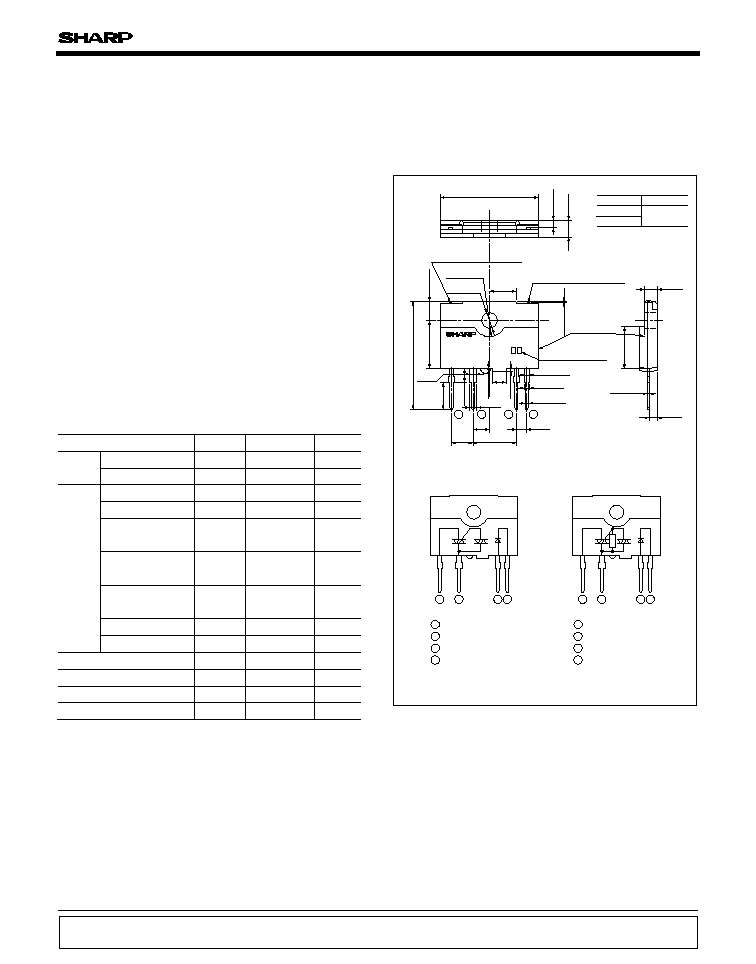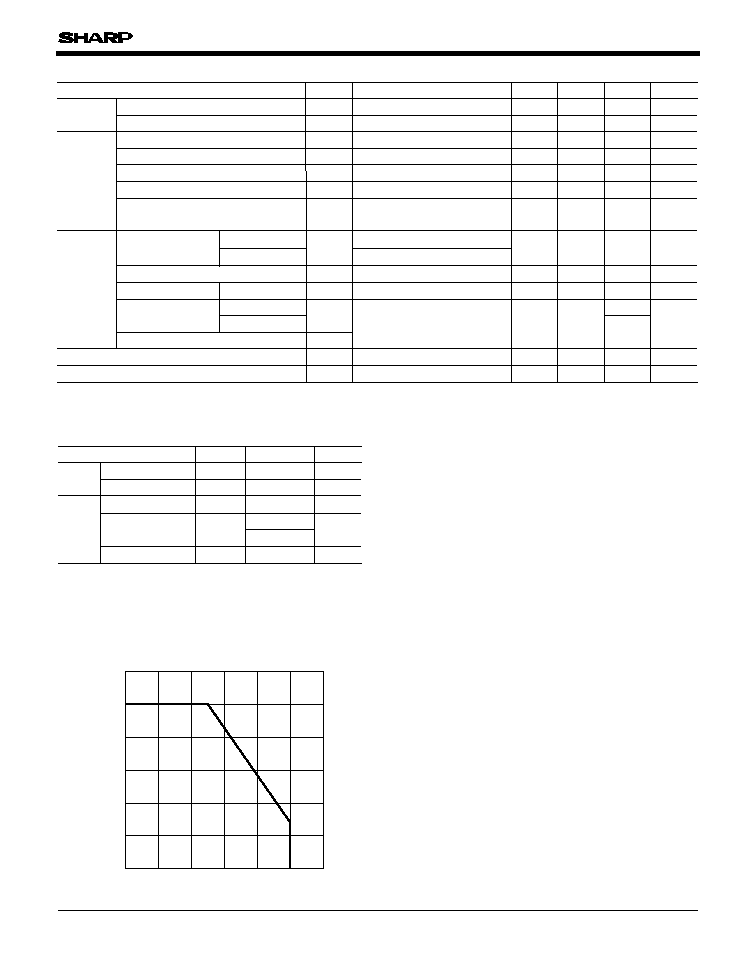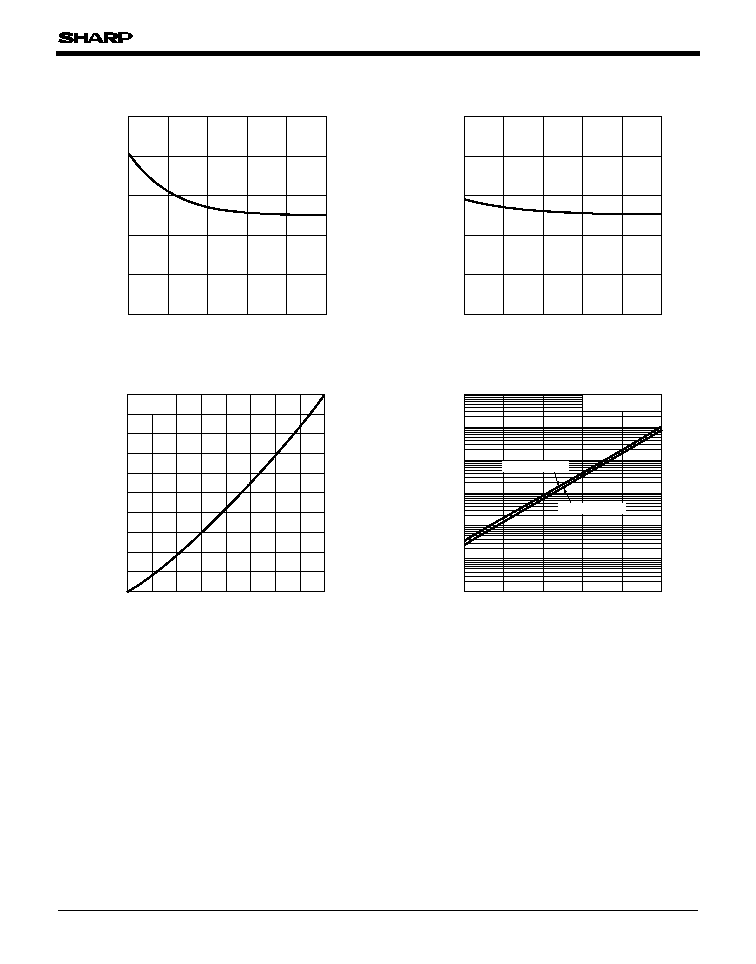
PR308T11ESZ/
PR308T21ESZ
PR308T11ESZ/PR308T21ESZ
s
Outline Dimensions
(Unit : mm)
s
Absolute Maximum Ratings
*1 Sine wave, practical value, Refer to Fig.1, 2
*2 50Hz sine wave, start at Tj
=
25∞C
*3 AC60Hz, for 1 min, 40 to 60%RH
Isolation voltage measuring method
1) Dielectric withstand voltage tester with zero cross circuit shall be used.
2) The applied voltage waveform shall be sine wave.
3) Voltage shall be applied between input and output.
(Input and output terminals shall all be shorted respectively.)
Parameter
Symbol
Rating
Unit
Forward current
I
F
50
8
mA
Reverse voltage
RMS ON-state current
Repetitive peak
OFF-state voltage
Peak one cycle surge current
Input
Output
V
R
6
V
A
A
V
A/
µ
s
I
surge
80
600
50
45 to 65
260
600
V
DRM
Non repetitive peak
OFF-state voltage
V
V
Hz
V
DSM
f
V
iso (rms)
I
T (rms)
kV
Isolation voltage
Operating temperature
T
opr
Load supply voltage
Operating frequency
dI
T
/dt
Critical rate of rise
of ON-state current
V
OUT (rms)
-
30 to
+
125
-
25 to
+
100
∞
C
∞
C
Storage temperature
T
stg
*3
*2
*1
Soldering temperature
T
sol
260 (For 10s)
3.0
∞
C
(Ta
=
25
∞
C)
1. Copiers
2. Facsimiles
3. Laser Printers
s
Features
s
Applications
Solid State Relay Approved by
European Safety Standard
1. Approved by European Safety Standards.
Thickness of the internal insulation:0.4mm or more
Creepage distance:6.4mm or more
Clearance:6.4mm or more
2. Isolation voltage (V
iso(rms)
:3kV)
3. RMS ON-state current I
T (rms)
:8A (Tc
80∞C)
4. Low profile package (23
◊
16
◊
4t mm)
5. Built-in zero-cross circuit
(PR308T21ESZ)
Notice
In the absence of confirmation by device specification sheets, SHARP takes no responsibility for any defects that may occur in equipment using any SHARP
devices shown in catalogs, data books, etc. Contact SHARP in order to obtain the latest device specification sheets before using any SHARP device.
Internet
Internet address for Electronic Components Group http://www.sharp.co.jp/ecg/
(3.8)
(5.08)
(10.16)
(2.54)
1
2
3
4
PR 3 0 8 T 1 1
8A260VAC
+ -
1.8
±
0.2
4.5
±
0.3
11.5
±
0.2
3.8
MAX.
.
0.2
MAX.
6.2
MIN.
1.6
±
0.2
3-1.2
±
0.2
6.4
±
0.2
Common to pin No.2
3-1.4
±
0.3
(3.5)
(0.8)
(25.8)
4
±
0.2
23
±
0.2
Z.C.
0.4
±
0.1
10
±
0.2
Lot No.
(DIN Standard)
Epoxy resin
4-0.8
±
0.2
1.8
±
0.3
0.1
MIN.
Common to pin No.2
3.7
±
0.2
R3.8
±
0.2
PR308T21ESZ
PR308T11ESZ
Internal connection diagram
1
2
3 4
1
2
3 4
Z.C. : Zero-cross circuit
( ) : Typical dimensions
2
1
3
4
Output (Triac T1)
Output (Triac T2)
Input (
+)
Input (
-)
2
1
3
4
Output (Triac T1)
Output (Triac T2)
Input (
+)
Input (
-)
Model No.
PR308T11
PR308T21
8A 260VAC
(1.8)
3
±
0.2

PR308T11ESZ/PR308T21ESZ
Parameter
Conditions
Input
Forward voltage
I
F
=
20mA
I
F
=
10mA
ON-state voltage
Output
Critical rate of rise of OFF-state voltage
V
D
=
2/3V
DRM
Tj
=
125∞C, V
D
=
2/3V
DRM
dI
T
/dt
=-
4.0A/mS
Transfer
charac-
teristics
Minimum trigger
current
V
D
=
12V, R
L
=
30
V
D
=
6V, R
L
=
30
V
D (rms)
=
200V, AC50Hz
I
T (rms)
=
2A, Resistance load, I
F
=
20mA
MIN.
-
-
30
10
10
TYP.
1.2
4.5
40
-
-
MAX.
1.4
1.5
-
-
-
Symbol
V
F
V
T (rms)
dV/dt
Commutation critical rate of rise
of OFF-state voltage
(dV/dt)c
I
FT
Isolation resistance
Zero-cross voltage
R
iso
V
OX
I
T (rms)
=
2A, Resistance load, I
F
=
20mA
Unit
V
Reverse current
V
R
=3V
V
D
=V
DRM
I
R
I
DRM
-
-
-
50
Holding current
I
H
mA
-
-
10
-
4
-
-
10
-
4
A
A
V/
µ
s
5
-
-
V/
µ
s
-
-
10
mA
V
-
-
35
V
(Ta
=
25∞C)
Turn-on time
Turn-off time
Thermal resistance (Between junction and case)
Thermal resistance (Between junction and ambience)
-
-
-
-
-
-
-
-
1
10
t
on
t
off
R
th (j-c)
R
th (j-a)
ms
∞C/W
∞C/W
DC
=
500V, 40 to 60%RH
PR308T11ESZ
PR308T21ESZ
PR308T21ESZ
PR308T11ESZ
PR308T21ESZ
Repetitive peak OFF-state current
s
Electrical Characteristics
*1 Without external heat sink (Ta
40∞C)
*2 With external heat sink (Tc
80∞C)
Parameter
Symbol
Conditions
Unit
20 to 30
80 to 240
mA
Input
Output
0 to 0.1
mA
V
A
Hz
0.5 to 2.0
0.5 to 8.0
47 to 63
*2
*1
I
F (on)
V
OUT (rms)
f
I
F (off)
I
OUT (rms)
Load supply voltage
Operating frequency
Load supply current
Signal current at ON
Signal current at OFF
s
Recommend Operating Conditions
0
10
20
30
40
50
60
-
25
0
25
50
75
100
125
Forward current I
F
(mA)
Ambient temperature T
a
(∞C)
Fig.1
Forward Current vs. Ambient
Temperature

PR308T11ESZ/PR308T21ESZ
RMS ON-state current I
T (rms)
(A)
Case temperature T
C
(
∞
C)
0
10
-
25
0
25
50
75
100
125
9
8
7
6
5
4
3
2
1
1
2
5
10
0.9
1.1
1
1.2
1.3
1.4
1.5
20
50
100
Forward current I
F
(mA)
Forward voltage V
F
(V)
T
a
=75∞C
50∞C
25∞C
0∞C
-
25∞C
Fig.3
RMS ON-state Current vs. Case
Temperature
Fig.5
Surge Current vs. Power-on Cycle
Fig.4
Forward Current vs. Forward Voltage
(Typical Value)
Surge current I
surge
(A)
Power-on cycle (Times)
0
1
10
100
f
=
50Hz
T
j
=
25
∞
C start
100
80
60
40
20
RMS ON-state current I
T
(A
rms
)
Ambient temperature T
a
(
∞
C)
0
9
8
7
6
5
4
3
2
1
-
25
100
75
50
25
125
0
(1)
(2)
(3)
(4)
(5)
4mm
Al plate
SSR
(1) With infinite heat sink
(2) With heat sink (200
◊
200
◊
2mm Al plate)
(3) With heat sink (100
◊
100
◊
2mm Al plate)
(4) With heat sink (50
◊
50
◊
2mm Al plate)
(5) Without heat sink
(Note) With the Al heat sink set up vertically, tighten the
device with a torque of 0.4N∑m and apply thermal
conductive silicone grease on the mounting face of
heat sink. Forced cooling shall not be carried out.
(Please use an isolation sheet if necessary.)
Fig.2 RMS ON-state Current vs. Ambient
Temperature

PR308T11ESZ/PR308T21ESZ
Maximum ON-state power dissipation (W)
RMS ON-state current I
T
(A)
0
10
8
6
4
2
7
5
3
1
0
8
6
4
2
9
7
5
3
1
T
a
=
25
∞
C
Repetitive peak OFF-state current I
DRM
(A)
Ambient temperature T
a
(
∞
C)
10
-
9
10
-
3
10
-
4
10
-
5
10
-
6
10
-
7
10
-
8
-
25
0
25
50
75
100
V
D
=
600V
PR308T21ESZ
PR308T11ESZ
Fig.8
Maximum ON-state Power Dissipation
vs. RMS ON-state Current (Typical Value)
Fig.9
Repetitive Peak OFF-state Current vs.
Ambient Temperature (Typical Value)
Minimum trigger current I
FT
(mA)
Ambient temperature T
a
(
∞
C)
(PR308T11ESZ)
0
10
-
25
0
25
50
75
100
8
6
4
2
V
D
=
12V
Minimum trigger current I
FT
(mA)
Ambient temperature T
a
(
∞
C)
(PR308T21ESZ)
0
10
-
25
0
25
50
75
100
8
6
4
2
V
D
=
6V
Fig.6
Minimum Trigger Current vs. Ambient
Temperature (Typical Value)
Fig.7
Minimum Trigger Current vs. Ambient
Temperature (Typical Value)

115
Application Circuits
NOTICE
qThe circuit application examples in this publication are provided to explain representative applications of
SHARP devices and are not intended to guarantee any circuit design or license any intellectual property
rights. SHARP takes no responsibility for any problems related to any intellectual property right of a
third party resulting from the use of SHARP's devices.
qContact SHARP in order to obtain the latest device specification sheets before using any SHARP device.
SHARP reserves the right to make changes in the specifications, characteristics, data, materials,
structure, and other contents described herein at any time without notice in order to improve design or
reliability. Manufacturing locations are also subject to change without notice.
qObserve the following points when using any devices in this publication. SHARP takes no responsibility
for damage caused by improper use of the devices which does not meet the conditions and absolute
maximum ratings to be used specified in the relevant specification sheet nor meet the following
conditions:
(i) The devices in this publication are designed for use in general electronic equipment designs such as:
--- Personal computers
--- Office automation equipment
--- Telecommunication equipment [terminal]
--- Test and measurement equipment
--- Industrial control
--- Audio visual equipment
--- Consumer electronics
(ii)Measures such as fail-safe function and redundant design should be taken to ensure reliability and
safety when SHARP devices are used for or in connection with equipment that requires higher
reliability such as:
--- Transportation control and safety equipment (i.e., aircraft, trains, automobiles, etc.)
--- Traffic signals
--- Gas leakage sensor breakers
--- Alarm equipment
--- Various safety devices, etc.
(iii)SHARP devices shall not be used for or in connection with equipment that requires an extremely
high level of reliability and safety such as:
--- Space applications
--- Telecommunication equipment [trunk lines]
--- Nuclear power control equipment
--- Medical and other life support equipment (e.g., scuba).
qContact a SHARP representative in advance when intending to use SHARP devices for any "specific"
applications other than those recommended by SHARP or when it is unclear which category mentioned
above controls the intended use.
qIf the SHARP devices listed in this publication fall within the scope of strategic products described in the
Foreign Exchange and Foreign Trade Control Law of Japan, it is necessary to obtain approval to export
such SHARP devices.
qThis publication is the proprietary product of SHARP and is copyrighted, with all rights reserved. Under
the copyright laws, no part of this publication may be reproduced or transmitted in any form or by any
means, electronic or mechanical, for any purpose, in whole or in part, without the express written
permission of SHARP. Express written permission is also required before any use of this publication
may be made by a third party.
qContact and consult with a SHARP representative if there are any questions about the contents of this
publication.




